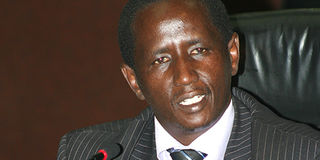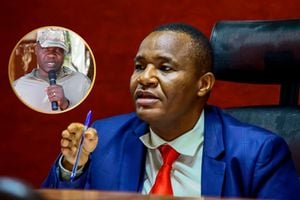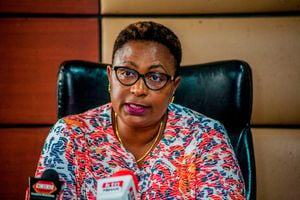Saitoti copter ‘lacked service pact’

Jennifer Muiruri | NATION
Kenya Civil Aviation Authority Airworthiness Manager Nicholas Muhoya when he appeared before the commission in Nairobi on August 09, 2012.
What you need to know:
- Witness tells inquest into the crash that police sought approval of the plane’s service facility after the accident
The helicopter, which crashed killing Internal Security minister George Saitoti and five others, was flying without an agreement on maintenance.
Documents seeking approval for a maintenance and service facility for the plane were submitted after the crash, an inquest into the crash heard on Thursday.
A witness confirmed to the commission investigating the accident that the aircraft was airborne before the police airwing identified an approved maintenance organisation to oversee its safety.
“There were still compliance areas to be attended to,” Mr Nicholas Muhoya, a Kenya Civil Aviation Authority (KCAA) airworthiness Manager, told the commission in cross examination by Lawyer Fred Ngatia, representing the Saitoti family.
Pending compliance
Mr Muhoya said the Eurocopter plane was registered after purchase from a South African firm and given the green light to fly despite pending compliance procedures.
It crashed on June 10 at Kibiku in Ngong, killing Prof Saitoti, his assistant Orwa Ojodeh, its pilots and police escorts on board.
“The process of identifying an approved maintenance organisation was still on going,” he said.
There was a proposal for the aircraft to be serviced by a private company at Wilson Airport but the agreement had not been finalised, according to the Mr Muhoya.
“I saw the proposal after the June 10 crash,” he said.
He said during registration stage, it was not mandatory to have the approval in place but it was one of the prerequisites before an airworthiness certificate is issued.
Asked by Mr Ngatia why a certificate of airworthiness was given to the police before they completed basic compliance procedures, the manager said the document was released from his office “by other people” while he was away.
He was also asked whether the police airwing had been authorised to service its own aircraft since they had not identified an organisation to offer the services.
Mr Muhoya said he was aware the airwing had not been approved but clarified that KCAA had no mandate to regulate the police.
Another witness, Engineer Salim Mohammed Dafala, who adjusted the aircraft’s compass after it was shipped from South Africa, said of his assessment of the machine: “There was nothing to worry for this helicopter.”
He said he gave it a clean bill of health after working on it in January 2012.
“ I did a compass swing for this helicopter after Chief Engineer Johnson Gitathu verbally requested me if I would do it,” he said.
He said he adjusted the compass because the plane had come from the Southern Hemisphere and its magnetic effect would be different in the Equatorial region.
“These are normal procedures for new aircraft,” he said.
The commission adjourned sittings yesterday to visit the Jomo Kenyatta International Airport and Wilson control towers to familiarise itself with communication facilities.
Witnesses continue to testify on Friday morning.




